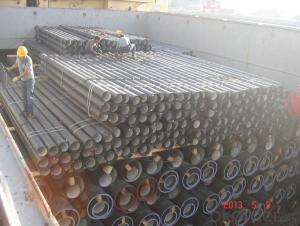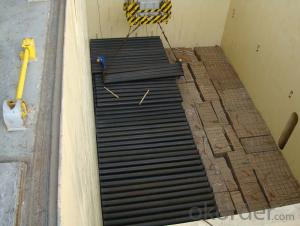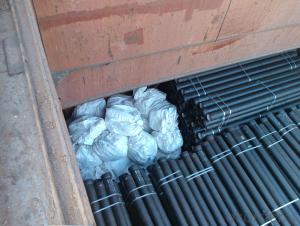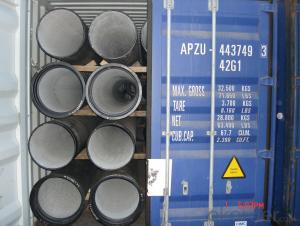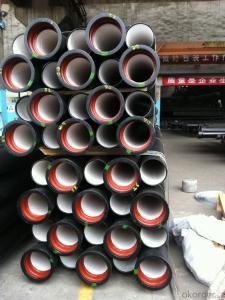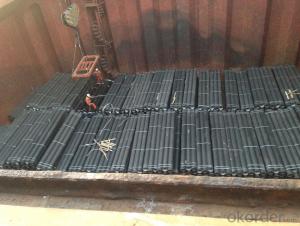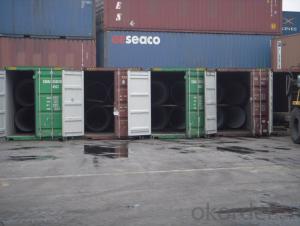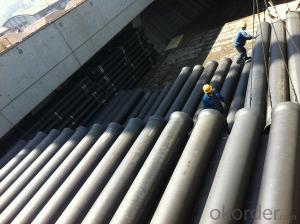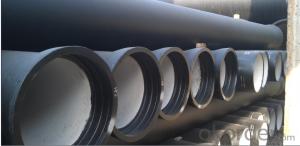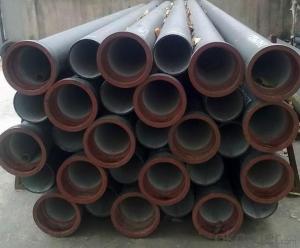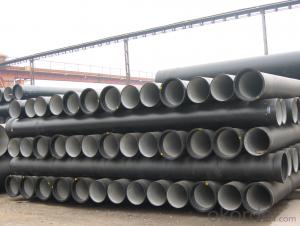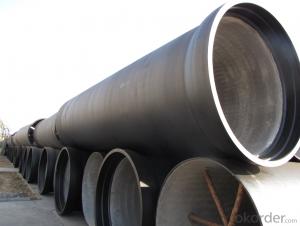ductile iron pipeDN450 K8 SOCKET SPIGOT PIPE
- Loading Port:
- Tianjin
- Payment Terms:
- TT OR LC
- Min Order Qty:
- 25 m.t
- Supply Capability:
- 30000 m.t/month
OKorder Service Pledge
OKorder Financial Service
You Might Also Like
Specification:
1) The standard of pipe: ISO2531:1998, K9
2) Effective length: 6m
3) Inner cement line: Portland cement line as per ISO4179
4) Zinc coating: at least 130g/m2 as per ISO8179
5) Bitumen painting: at least 70um as per ISO8179
6) With 100% quantity of NBR ring, or SBR ring, or EPDM ring as per ISO4633
7) DN80mm-800mm
8) High strength, lighter than grey iron, good corrosion resistance, no furring, small flow resistance, easy fixing, long life tome about 100 yeas
9) Produced by Hangzhou chunfeng machine
10) Checked by automatic inspection equipment
11) Composition:
Chemical composition | ||||||
Chemical composition | Ductile Cast Iron Pipe (%) | Grey iron pipe (%) | Steel pipe (%) | |||
C | 3.5-4.0 | 3.2-3.8 | 0.1-0.2 | |||
Si | 1.9-2.6 | 1.4-2.2 | 0.15-0.4 | |||
Mn | 0.15-0.45 | 0.4-0.6 | 0.3-0.6 | |||
P | ≤0.06 | ≤0.3 | 0.02-0.03 | |||
S | ≤0.02 | ≤0.1 | 0.02-0.03 | |||
Mg | 0.03-0.06 | |||||
12) Feature:
Mechanical properties | ||||||
Ductile Cast Iron Pipe | Grey Iron Pipe | Steel Pipe | ||||
Tensile Strength(Mpa) | ≥420 | 150-260 | ≥400 | |||
Yield Strength(Mpa) | ≥300 | No Confirmation | No Confirmation | |||
Bending Strength(Mpa) | ≥590 | 200-360 | ≥400 | |||
Elongation (%) | ≥10 | Neglected | ≥18 | |||
Brinell Hardness(HBS) | ≤230 | ≤230 | About 140 | |||
13) T type mechanical joint
14) Packing: in bulk or container
- Q: How does ductile iron pipe perform in extreme temperatures?
- Ductile iron pipe is known for its exceptional performance in extreme temperatures. Due to its unique composition and manufacturing process, ductile iron pipe can withstand both high and low temperatures without compromising its structural integrity. In high-temperature environments, ductile iron pipe demonstrates excellent heat resistance. It can withstand temperatures up to 1000 degrees Fahrenheit, making it suitable for applications that involve hot liquids or gases, such as steam pipelines or industrial processes. The high strength and thermal stability of ductile iron allow it to maintain its shape and structural integrity even under extreme heat conditions, ensuring long-term reliability and safety. Similarly, ductile iron pipe also performs well in low-temperature environments. It can endure sub-zero temperatures without becoming brittle or prone to cracking, which is a common issue with other materials like cast iron. This makes ductile iron pipe ideal for applications in cold climates, such as water distribution systems in freezing temperatures. Furthermore, ductile iron pipe's ability to resist thermal expansion and contraction is another advantage in extreme temperatures. It has a low coefficient of thermal expansion, meaning it expands and contracts less compared to other materials. This property helps to minimize the stress on the pipe and reduces the risk of leaks or failures caused by temperature fluctuations. In summary, ductile iron pipe exhibits exceptional performance in extreme temperatures. Its heat resistance, ability to withstand low temperatures, and resistance to thermal expansion and contraction make it a reliable choice for various applications, ensuring safe and efficient operations even in challenging environments.
- Q: What is the expected fire resistance of ductile iron pipes?
- The expected fire resistance of ductile iron pipes is high due to their ability to withstand high temperatures without losing structural integrity. They have a melting point of approximately 1200°C, making them suitable for applications where fire protection is crucial.
- Q: Are ductile iron pipes resistant to abrasion?
- Yes, ductile iron pipes are resistant to abrasion. Ductile iron is a type of cast iron that has been treated with magnesium to improve its strength and ductility. This makes it highly resistant to wear and tear, including abrasion. Ductile iron pipes are commonly used in applications where they may come into contact with abrasive materials such as sand, gravel, or other particles in the flow. The material's ability to withstand abrasion helps ensure its long-term durability and reliability in various industries, including water distribution, sewer systems, and industrial pipelines.
- Q: Method for joining cast iron pipes
- The connection between the pipe and the pipe adopts the form of socket type or flange disk interface. According to the function, it can be divided into two kinds: flexible interface and rigid interface. The flexible interface is sealed with rubber ring, which allows a certain degree of corner and displacement, so it has good seismic resistance and tightness. It is easy and quick to install than rigid interface. It has little labor intensity according to the casting method.
- Q: How are ductile iron pipes repaired in case of damage?
- Ductile iron pipes are commonly used in various applications due to their high durability and strength. However, like any other materials, they can experience damage over time due to external factors or internal corrosion. In such cases, there are several methods available for repairing ductile iron pipes. One common method is known as the trenchless repair technique. This method involves repairing the damaged section of the pipe without the need for extensive excavation. It typically includes the use of specialized equipment to access the damaged area and carry out the necessary repairs. This technique is particularly beneficial as it reduces disruption to the surrounding area and minimizes costs associated with excavation. Another method for repairing ductile iron pipes is the use of epoxy lining. This technique involves applying a layer of epoxy resin to the interior surface of the pipe, effectively sealing any cracks or leaks. Epoxy lining is an effective and cost-efficient solution, as it provides a long-lasting repair and improves the overall condition of the pipe. In cases where the damage is severe or extensive, the damaged section of the ductile iron pipe may need to be replaced. This typically involves cutting out the damaged portion and installing a new section of pipe. The replacement process may require excavation and can be more time-consuming and costly compared to other repair methods. However, it ensures a complete and permanent solution for the damaged pipe. It is worth noting that the specific repair method chosen for ductile iron pipes depends on the extent of the damage, accessibility, and other factors. Professional assessment and inspection are crucial to determine the most suitable repair technique. Consulting with experienced pipeline repair specialists or civil engineers is highly recommended to ensure the most effective and durable repair solution for ductile iron pipes.
- Q: Are ductile iron pipes available for cutting and are there any relevant specifications?
- Ductile iron pipes can be divided into cutting and non cutting pipes, the cutting pipe can be cut, and the cutting pipe is usually marked with "scissors" mark in the pipeline.
- Q: Do ductile iron pipes require external coatings or wraps?
- Yes, ductile iron pipes typically require external coatings or wraps for protection against corrosion and to extend their lifespan.
- Q: How does ductile iron pipe compare to PVC pipe in terms of performance and cost?
- Ductile iron pipe and PVC pipe have different characteristics in terms of performance and cost. Ductile iron pipe is known for its strength, durability, and ability to withstand high pressure and heavy loads, making it ideal for applications that require robust performance such as water distribution systems. On the other hand, PVC pipe is lightweight, corrosion-resistant, and more flexible, making it suitable for above-ground and non-pressurized applications like drainage systems. In terms of cost, PVC pipe is generally less expensive than ductile iron pipe, especially for smaller diameter pipes. However, as the diameter increases, ductile iron pipe becomes more cost-effective due to its superior strength and longer lifespan, which reduces maintenance and replacement costs over time. Ultimately, the choice between ductile iron and PVC pipe depends on the specific application, budget, and desired performance characteristics.
- Q: Ductile iron pipe connection mode
- The connection mode of ductile iron pipe installation program: clean up the socket socket to clean up on the apron, apron, pipe (tube), Jack in appearance and rubber brush lubricant to push the pipe into socket to check.
- Q: What are the different accessories available for ductile iron pipe?
- To enhance the functionality and ensure efficient operation of ductile iron pipes, there is a range of accessories available. Some commonly used accessories include: 1. Flange Adapters: These accessories allow for the connection of ductile iron pipes with other pipe materials or equipment, such as valves, pumps, or fittings. Flange adapters provide a secure and leak-proof connection. 2. Mechanical Joint Fittings: These fittings are employed to join ductile iron pipes together. They consist of a gland, gland follower, and bolts, enabling a flexible and easily adjustable connection. 3. Restrained Joint Fittings: These fittings are utilized in applications where it is necessary to restrain the pipe to prevent movement or separation. They ensure stability and prevent potential damage caused by external forces or pressure. 4. Thrust Blocks: Concrete structures known as thrust blocks are employed to resist the thrust generated by internal pressure in ductile iron pipes. They prevent pipe movement and maintain stability. 5. Valve Boxes: Valve boxes offer protection and easy access to valves installed along the ductile iron pipeline. They are typically made of cast iron or polymer materials and are available in various sizes and designs. 6. Hydrant Assemblies: Hydrant assemblies are installed for the purpose of fire protection. They consist of a ductile iron pipe, a hydrant valve, and a fire hydrant. These assemblies are crucial for quick access to water during firefighting operations. 7. Tapping Saddles: Tapping saddles are employed to create a branch connection on a ductile iron pipe without interrupting the flow. They provide a convenient way to install service connections, valves, or meters. 8. Pipe Restraints and Supports: These accessories are used to secure ductile iron pipes to structures or prevent excessive movement. They help maintain proper alignment, prevent sagging, and ensure the structural integrity of the pipeline. 9. Pipe Repair Clamps: In the event of pipe damage or leaks, repair clamps offer a quick and temporary solution. These clamps are designed to fit around the damaged area and provide a tight seal to stop the leak. 10. Gaskets and Seals: Gaskets and seals are crucial accessories for ensuring leak-free connections. They are available in various materials, such as rubber or synthetic compounds, and are used to create a watertight seal between pipes or fittings. These are just a few examples of the accessories available for ductile iron pipes. The selection of accessories depends on the specific requirements of the project, and it is recommended to consult with a pipe supplier or engineer to ensure the appropriate accessories are chosen for the application.
Send your message to us
ductile iron pipeDN450 K8 SOCKET SPIGOT PIPE
- Loading Port:
- Tianjin
- Payment Terms:
- TT OR LC
- Min Order Qty:
- 25 m.t
- Supply Capability:
- 30000 m.t/month
OKorder Service Pledge
OKorder Financial Service
Similar products
Hot products
Hot Searches
Related keywords
